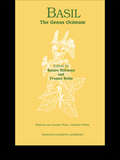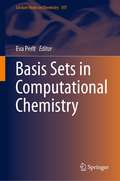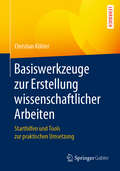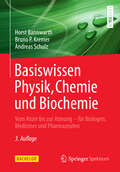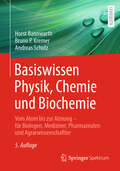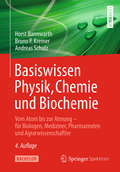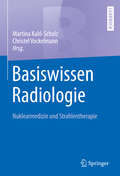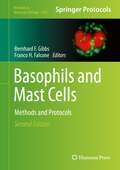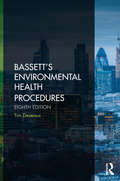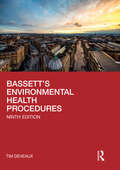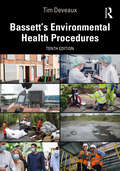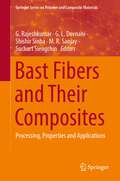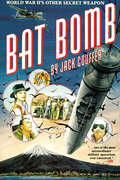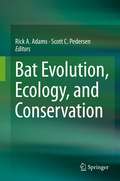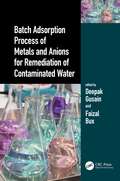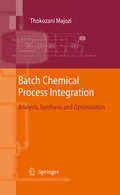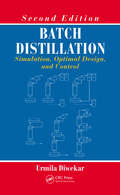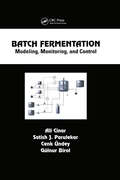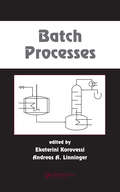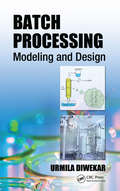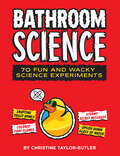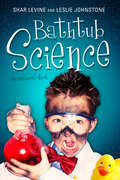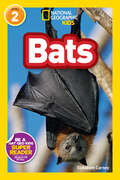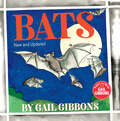- Table View
- List View
Basil: The Genus Ocimum (Medicinal And Aromatic Plants - Industrial Profiles Ser.)
by Raimo Hiltunen Yvonne HolmCovering all the research areas regarding Ocimum such as botany, chemistry and pharmacology, this book will be of interest to everybody involved in medicinal and aromatic plant research or related fields.
Basis Sets in Computational Chemistry (Lecture Notes in Chemistry #107)
by Eva PerltThis book addresses the construction and application of the major types of basis sets for computational chemistry calculations. In addition to a general introduction, it includes mathematical basics and a discussion of errors arising from incomplete or inappropriate basis sets. The different chapters introduce local orbitals and orbital localization as well as Slater-type orbitals and review basis sets for special applications, such as those for correlated methods, solid-state calculations, heavy atoms and time-dependent adaptable Gaussian bases for quantum dynamics simulations. This detailed review of the purpose of basis sets, their design, applications, possible problems and available solutions provides graduate students and beginning researchers with information not easily obtained from the available textbooks and offers valuable supporting material for any quantum chemistry or computational chemistry course at the graduate and/or undergraduate level. This book is also useful as a guide for researchers who are new to computational chemistry but are willing to extend their research tools by applying such methods.
Basiswerkzeuge zur Erstellung wissenschaftlicher Arbeiten: Starthilfen und Tools zur praktischen Umsetzung
by Christian KöhlerDieses Buch bietet eine kompakte Starthilfe zur Erstellung wissenschaftlicher Arbeiten, wie Seminar-, Studien- und Praxisarbeiten sowie der Bachelor- oder Masterthesis. Die Basiswerkzeuge sind in eine humorvolle Rahmengeschichte mit drei typischen Protagonisten eingebettet. Auf deren Problemen, Erfahrungen, Recherchen und typischen Fehlern bauen die einzelnen Lerneinheiten auf. Dabei wurden die wichtigsten Lei(d)tfragen in hilfreiche Tools zur leicht nachvollziehbaren Anwendung überführt und übersichtlich zusammengefasst. Das Buch vermittelt die Fähigkeit zum selbstständigen Einarbeiten in komplexe Sachverhalte, zur kritischen Reflexion und nachvollziehbaren Argumentation.
Basiswissen Physik, Chemie und Biochemie: Vom Atom bis zur Atmung - für Biologen, Mediziner und Pharmazeuten (Bachelor)
by Bruno P. Kremer Horst Bannwarth Andreas SchulzErste Hilfe in Physik und Chemie: die Basics für das erfolgreiche Bachelorstudium. Physikalische, chemische und biochemische Grundlagen sind unverzichtbar für das Verständnis von Biologie, Medizin, Pharmazie, Ernährungs- und Umweltwissenschaften. Dieses Buch bietet im kompakten Überblick das gesamte Basiswissen dieser Grundlagendisziplinen in leicht verständlichen Texten und Abbildungen, bei Beschränkung auf das wirklich Notwendige, abgestimmt auf die Gegenstandskataloge für den Ersten Abschnitt der Ärztlichen und der Pharmazeutische Prüfung, zur leichteren Orientierung im Grundstudium, und zur optimalen Vorbereitung für die Vor- oder Zwischenprüfung. Die neue Auflage wurde aktuell überarbeitet. Sie enthält auch ein komplett neues Kapitel über Stoffe, Energie und Information. Das ideale Lernbuch zur Physik und Chemie in Biologie, Medizin, Pharmazie, Ernährungs- und Umweltwissenschaften.
Basiswissen Physik, Chemie und Biochemie: Vom Atom bis zur Atmung – für Biologen, Mediziner, Pharmazeuten und Agrarwissenschaftler
by Bruno P. Kremer Horst Bannwarth Andreas SchulzDieses Buch bietet im kompakten Überblick das gesamte Basiswissen der Physik, Chemie und Biochemie in leicht verständlichen Texten und Abbildungen, bei Beschränkung auf das wirklich Notwendige. Es ist abgestimmt auf die Gegenstandskataloge für den ersten Abschnitt der Ärztlichen und der Pharmazeutischen Prüfung. Für Studierende der Biologie, der Ernährungs- und Umweltwissenschaften sowie der Agrarwissenschaften dient es zur leichteren Orientierung im Grundstudium und zur optimalen Vorbereitung für die Vor- oder Zwischenprüfung. Neben vielen kleinen Ergänzungen in den meisten Buchteilen wurde das Kapitel Thermodynamik neu gefasst und enthält jetzt einen Abschnitt zur Erdatmosphäre. Im Biochemieteil wird die neue Rolle von mRNA als Impfstoff und Medikament behandelt.
Basiswissen Physik, Chemie und Biochemie: Vom Atom bis zur Atmung – für Biologen, Mediziner, Pharmazeuten und Agrarwissenschaftler (Bachelor Ser.)
by Bruno P. Kremer Horst Bannwarth Andreas SchulzDieses Buch bietet im kompakten Überblick das gesamte Basiswissen der Physik, Chemie und Biochemie in leicht verständlichen Texten und Abbildungen, bei Beschränkung auf das wirklich Notwendige. Es ist abgestimmt auf die Gegenstandskataloge für den ersten Abschnitt der Ärztlichen und der Pharmazeutischen Prüfung. Für Studierende der Biologie, der Ernährungs- und Umweltwissenschaften dient es zur leichteren Orientierung im Grundstudium und zur optimalen Vorbereitung für die Vor- oder Zwischenprüfung. Für diese Neuauflage haben die Autoren alle Kapitel durchgängig aktualisiert.
Basiswissen Radiologie: Nuklearmedizin und Strahlentherapie (Springer-Lehrbuch)
by Martina Kahl-Scholz Christel Vockelmann#65533;bersichtlich und kompakt bietet Ihnen dieses Lehrbuch einen vollst#65533;ndigen #65533;berblick #65533;ber alle pr#65533;fungsrelevanten Inhalte der Radiologie. Es leitet Sie leicht verst#65533;ndlich und GK-orientiert durch das gesamte Basiswissen von den Grundlagen bis hin zu den wichtigsten Krankheitsbildern, inklusive der Nuklearmedizin und der Strahlentherapie. Profitieren Sie von der langj#65533;hrigen Erfahrung der Dozenten, die sorgf#65533;ltig das Wesentliche f#65533;r Sie ausgew#65533;hlt und aufbereitet haben.
Basophils and Mast Cells: Methods and Protocols (Methods in Molecular Biology #2163)
by Bernhard F. Gibbs Franco H. FalconeThis second edition provides updated and new chapters to build on and extend the strengths of the first edition. Chapters guide readers through basic biology of basophils, obtaining the cells by purification, culture of stem cells progenitors, peripheral CD34+ stem cell-derived mast cells, basophils from CD34+ progenitors, diagnostic applications, gene expression patterns in basophils, roles of basophils in different asthma phenotypes, knockout, and disease models. Written in the highly successful Methods in Molecular Biology series format, chapters include introductions to their respective topics, lists of the necessary materials and reagents, step-by-step, readily reproducible laboratory protocols, and tips on troubleshooting and avoiding known pitfalls. Authoritative and cutting-edge, Basophils and Mast Cells: Methods and Protocols, Second Edition aims to ensure successful results in the further study of this vital field.
Bassett's Environmental Health Procedures
by Tim Deveaux W.H. BassettEnvironmental health law is a wide-ranging, detailed and complex body of law within the UK. Environmental Health Procedures is an established and essential reference source which provides an accessible entry into enforcement and administrative procedures for environmental health. The main legal procedures used in the environmental health field are presented as flow charts supported by explanatory text. The structure of this eighth edition has been revised for ease of use, with each chapter now addressing a single topic instead of a piece of legislation. It also introduces legal guidance for environmental health practitioners to prepare them for the court prosecutions that are an essential part of their work. The book has been updated throughout to reflect new practices, legislation and statutory guidance including: Primary Authorities Authorisations for public water supplies Infectious disease control Port Health RIDDOR Environmental permitting Environmental damage Imported food Empty homes Licensing of housing Licensing of gambling activities Environmental Health Officers/Practitioners and students will find this book invaluable. It will also be an essential reference for all those whose responsibilities demand they keep abreast of current environmental health practices.
Bassett's Environmental Health Procedures
by Tim Deveaux W.H. BassettEnvironmental health law is a wide-ranging, detailed and complex body of law within the UK. Bassett’s Environmental Health Procedures is an established and essential reference source which provides an accessible entry into enforcement and administrative procedures for environmental health. The main legal procedures used in the environmental health field are presented as flow charts supported by explanatory text. This ninth edition refines the structure introduced in the eighth edition, with each chapter addressing a single topic. It has introduced the titles of the corresponding legislation in Scotland and Northern Ireland where there is such legislation. The book has been updated throughout to reflect new practices, legislation and statutory guidance. Specifically, the ninth edition contains new content on Antisocial Behaviour and significant updates to sections on: Enforcement and Administration Environmental Protection Food Safety Housing and Public Health Environmental Health Officers/Practitioners and students will find this book invaluable. It will also be an essential reference for all those whose responsibilities demand they keep abreast of current environmental health practices.
Bassett's Environmental Health Procedures
by Tim Deveaux W.H. BassettBassett’s Environmental Health Procedures is a long-standing, must-have reference book for practising environmental health officers in local government and in private practice. It covers all the key legislative procedures for the service of a wide range of notices to deal with public health problems throughout the UK. The tenth edition covers the following subjects and reflects new practices, legislation and statutory guidance: The legal framework Environmental protection – including air quality, noise, pollution control Food safety Health and safety at work Housing Port health Public health Each procedure includes a simple description of the legislation and a flow diagram showing the procedure to follow in using that legislation. Written for the increasingly pressurised local authority environmental health practitioner, this book will help them to understand the legislation quickly and easily and how to deploy it effectively. Bassett’s is also an essential reference for all those whose responsibilities demand they keep abreast of current environmental health practices.
Bast Fibers and Their Composites: Processing, Properties and Applications (Springer Series on Polymer and Composite Materials)
by Suchart Siengchin G. Rajeshkumar Shishir Sinha G. L. Devnani M. R. SanjayThis edited book focuses on processing, properties, and applications of bast fiber and its composites written by renowned researchers and academicians. The contents focus on properties such as rheological and dielectric of bast fiber composites. It also discusses its dynamic mechanical analysis, thermal stability of polymer composites reinforced with bast fibers, and water absorption behavior of bast fiber incorporated polymer composites. This book will be beneficial to both the industry and academia as it highlights possible avenues of future research.
Bat Bomb: World War II's Other Secret Weapon
by Jack Couffer&“Inside information on a wondrously droll, highly classified yarn from WWII . . . A well-told, stranger-than-fiction tale that could make a terrific movie.&” —Kirkus Reviews The plan: attach small incendiary bombs to millions of bats and release them over Japan&’s major cities. As the bats went to roost, a million fires would flare up in remote crannies of the wood and paper buildings common throughout Japan. When their cities were reduced to ashes, the Japanese would surely capitulate . . . Told here by the youngest member of the team, this is the story of the bat bomb project, or Project X-Ray, as it was officially known. In scenes worthy of a Capra or Hawks comedy, Jack Couffer recounts the unorthodox experiments carried out in the secrecy of Bandera, Texas, Carlsbad, New Mexico, and El Centro, California, in 1942-1943 by &“Doc&” Adams&’ private army. This oddball cast of characters included an eccentric inventor, a distinguished Harvard scientist, a biologist with a chip on his shoulder, a movie star, a Texas guano collector, a crusty Marine Corps colonel, a Maine lobster fisherman, an ex-mobster, and a tiger. The bat bomb researchers risked life and limb to explore uncharted bat caves and &“recruit&” thousands of bats to serve their country, certain that they could end the war with Japan. And they might have—in their first airborne test, the bat bombers burned an entire brand-new military airfield to the ground. For everyone who relishes true tales of action and adventure, Bat Bomb is a must-read. Bat enthusiasts will also discover the beginnings of the scientific study of bats.
Bat Evolution, Ecology, and Conservation
by Rick A. Adams Scott C. PedersenRecent advances in the study of bats have changed the way we understand this illusive group of mammals. This volume consist of 25 chapters and 57 authors from around the globe all writing on the most recent finding on the evolution, ecology and conservation of bats. The chapters in this book are not intended to be exhaustive literature reviews, but instead extended manuscripts that bring new and fresh perspectives. Many chapters consist of previously unpublished data and are repetitive of new insights and understanding in bat evolution, ecology and conservation. All chapters were peer-reviewed and revised by the authors. Many of the chapters are multi-authored to provide comprehensive and authoritative coverage of the topics.
Bat Island: A Rare Journey into the Hidden World of Tropical Bats
by Dr. Rachel A. Page Dr. Dina K. Dechmann Dr. M. Teague O'Mara Dr. Marco Tschapka The Smithsonian Tropical Research InstituteFeaturing incredible photography and insight from an international team with long-term ties to the Smithsonian Tropical Research Institute, Bat Island spotlights the unique beauty and environmental importance of the seventy-six species of bats on Panama&’s Barro Colorado Island.For decades, scientists at the Smithsonian Tropical Research Institute have studied the remarkable biodiversity of bats on Barro Colorado Island in Panama, where an astonishing seventy-six species coexist. Now, for the first time, Smithsonian scientists&’ expertise pairs with the stunning photography of National Geographic contributor Christian Ziegler for a captivating visual journey into the fascinating world of these elusive night creatures. Bats are unique among mammals: they have acquired true flight, provide essential ecosystem services, and represent the ecologically most diverse group of mammals worldwide. Synthesizing decades-worth of intensive study, Drs. Rachel Page, Dina Dechmann, Teague O&’Mara, and Marco Tschapka provide authoritative insight alongside 150 photographs that showcase bats&’ extraordinary environmental adaptations and rich natural history. OVER 150 STUNNING PHOTOGRAPHS: National Geographic photographer and contributor Christian Ziegler has captured over a decade&’s worth of images of the myriad of bat species living on Barro Colorado Island that capture these elusive animals in a variety of settings, from night shots of flight through the tropical rainforest to closeups of their remarkable wings and feeding patterns. WRITTEN BY SMITHSONIAN SCIENTISTS: All chapters of Bat Island are written by scientists long affiliated with the Smithsonian Tropical Research Institute, one of the world&’s leading tropical research organizations that spans a century. Topics include bats&’ diverse sensory abilities, foraging strategies, roosting ecologies, and social systems. DECADES OF CUTTING-EDGE RESEARCH: Bat Island, published in partnership with the Smithsonian, presents fascinating insights from scientists working at the Smithsonian Tropical Research Institute, which boasts decades of study of the hyperdiverse bat population on Barro Colorado Island in addition to the most comprehensive and long-term datasets on tropical bats. CALL FOR CONSERVATION: Drs. Page, Dechmann, O&’Mara, and Tschapka highlight how bats are threatened by habit fragmentation and land degradation, and communicate the initiatives needed to ensure the survival of these animals, which are critical to maintaining healthy, balanced ecosystems. RARE BEAUTY: Award-winning photojournalist Christian Ziegler&’s photography illuminates the unique beauty and allure of bats and the tropical rainforest in Panama.
Batch Adsorption Process of Metals and Anions for Remediation of Contaminated Water
by Faizal Bux Deepak GusainAdsorption is one of the method that is in use for remediation of contaminated water. The experimental factors affecting the batch mode of adsorption of various metals and inorganic anions are discussed in this book. The elemental contaminants have been categorized into four major categories i.e. major toxic elements; essential elements having toxicity on excessive exposure; miscellaneous elements having undetermined effects; non-toxic elements having trivial or unidentified significance. In addition, anions like nitrate, perchlorate and sulphate as water contaminants are considered. This unique volume fills a niche in the area of water treatment. Key Features: Provides practitioners with the background they need to understand and apply batch adsorption processes to the purification of water Describes the actions of adsorption capacity or percentage removal with respect to factors affecting the adsorption process Excellent source of information for those working in the industry for remediation of metals and anions Discusses the current era of Anthropocene which is highly dependent on the anthropogenic mineral sources for its sustenance
Batch Chemical Process Integration: Analysis, Synthesis and Optimization
by Thokozani Majozi"Batch Chemical Process Integration: Analysis, Synthesis and Optimization" is an excellent source of information on state-of-the-art mathematical and graphical techniques for analysis, synthesis and optimization of batch chemical plants. It covers recent techniques in batch process integration with a particular focus on the capabilities of the mathematical techniques. There is a section on graphical techniques as well as performance comparison between graphical and mathematical techniques. Prior to delving into the intricacies of wastewater minimisation and heat integration in batch processes, the book introduces the reader to the basics of scheduling which is aimed at capturing the essence of time. A chapter on the synthesis of batch plants to highlight the importance of time in design of batch plants is also presented through a real-life case study. The book is targeted at undergraduates and postgraduate students, researchers in batch process integration, practising engineers and technical managers.
Batch Distillation: Simulation, Optimal Design, and Control, Second Edition (Series In Chemical And Mechanical Engineering)
by Urmila DiwekarMost available books in chemical engineering mainly pertain to continuous processes, with batch distillation relegated to a small section. Filling this void in the chemical engineering literature, Batch Distillation: Simulation, Optimal Design, and Control, Second Edition helps readers gain a solid, hands-on background in batch processing. The seco
Batch Fermentation: Modeling: Monitoring, and Control (Chemical Industries)
by Ali Cinar Satish J. Parulekar Cenk Undey Gulnur BirolIllustrating techniques in model development, signal processing, data reconciliation, process monitoring, quality assurance, intelligent real-time process supervision, and fault detection and diagnosis, Batch Fermentation offers valuable simulation and control strategies for batch fermentation applications in the food, pharmaceutical, and chemical industries. The book provides approaches for determining optimal reference trajectories and operating conditions; estimating final product quality; modifying, adjusting, and enhancing batch process operations; and designing integrated real-time intelligent knowledge-based systems for process monitoring and fault diagnosis.
Batch Processes
by Andreas A. Linninger Ekaterini KorovessiReduced time to market, lower production costs, and improved flexibility are critical success factors for batch processes. Their ability to handle variations in feedstock and product specifications has made them key to the operation of multipurpose facilities, and therefore quite popular in the specialty chemical, pharmaceutical, agricultural, and
Batch Processing: Modeling and Design
by Urmila DiwekarBatch processes are widely used in pharmaceutical, food, and specialty chemicals where high value, low volume products are manufactured. Designing these processes and unit operations can be an onerous task that requires computational efforts. With examples, case studies, and more than 100 homework problems, this book presents an overview of computer-aided design packages and describes the unit operations in batch and bioprocessing. Providing students with a thorough grounding in the numerical methods necessary to solve design problems, it discusses the basics of design, modeling, and optimization. Figure slides are available upon qualifying course adoption.
Bathroom Science: 70 Fun and Wacky Science Experiments
by Christine Taylor-ButlerFor kids who dare to do make things ooze, pop, stink, and erupt.Create exploding toilet volcanoes, oozing sink slime, and bubbling bathtub cauldrons...all in the name of science! Each step-by-step experiment uses household and other easy-to-find materials so the young scientist’s lab can be equipped quickly, inexpensively, and—for those who might worry—safely. Bathroom Science highlights the materials, the method, and the scientific "why" behind every experiment. It's spiral bound to stay open while young scientists-in-training measure and mix. And, best of all, Bathroom Science makes science as simple (and occasionally explosive) as going to the bathroom. We’ve packed in 101 kid-challenging experiments, including...*Turn Your Toilet into a Volcano*Steam Up a Secret Message*Fill the Sink with Booger Slime*Give Bathwater an Eerie Glow*The Cackling Chicken of Death, and*Make Your Own Stink Bomb (Eew!) The folks who brought you Uncle John’s Bathroom Reader...creating the next generation of mad (and amazing) scientists, one kid at a time! (Bwa-ha-ha!)
Bathtub Science
by Shar LevineStart the taps flowing and get ready for fun as your bathtub becomes a laboratory for inquisitive and adventurous kids! Ever wondered how to make your own hydroplane that zips across the water? Want to blast yourself clean with a powerful water cannon? Look underwater with a homemade periscope? Transform your bathroom into a workshop where you can conduct mind-blowing experiments, learn scientific principles, and wow your friends by explaining the science behind these and many other fantastic experiments. Designed by the acclaimed authors of several science books for kids, each experiment provides a list of the household materials you will need, clear, step-by-step instructions for conducting experiments, questions to guide your observations and an explanation of what you see. In the enhanced ebook, children and their parents can watch great interactive videos that accompany each experiment, listen to amazing audio, and be inspired to become science geeks along the way.
Bats (National Geographic Kids Readers)
by Elizabeth CarneyThey live in spooky caves, in forests, even in the dark reaches of ordinary attics and bridges. They flock by the hundreds, and they sleep while hanging upside down! In this beautifully photographed Level 2 Reader, kids learn about one of the most interesting creatures around—and discover the bat&’s unique place in the wild and in the world. The high-interest topic, expertly written text, and bonus learning activity lay the groundwork for a successful and rewarding reading experience.National Geographic supports K-12 educators with ELA Common Core Resources.Visit www.natgeoed.org/commoncore for more information.
Bats (New & Updated Edition)
by Gail GibbonsPresenting fascinating information on all kinds of bats, from how they use echoes to hear, to the legends that surround them and how to protect the speciesThough people often think of bats as scary, bats are really shy, gentle animals. There are nearly 1000 different species of bats, and they live on every continent except Antarctica. Some are tiny, but the giant flying fox bat has a five-foot wingspan! Popular science author Gail Gibbons also discusses the efforts to protect the world's only truly flying mammals. A final page offers additional facts.
